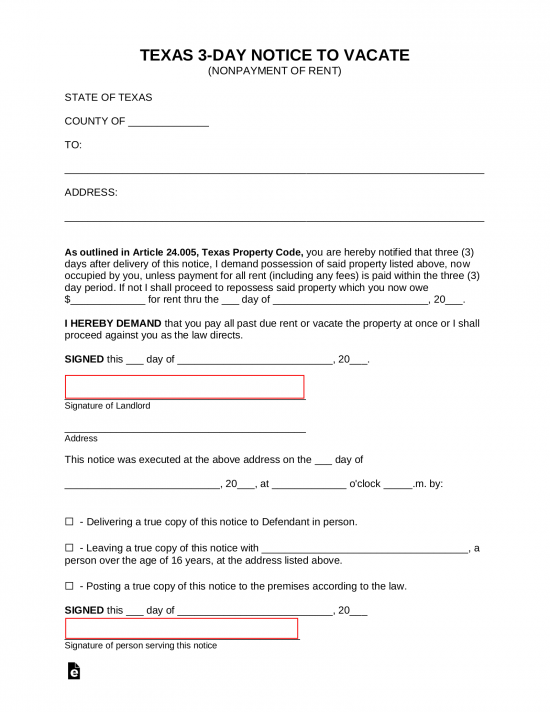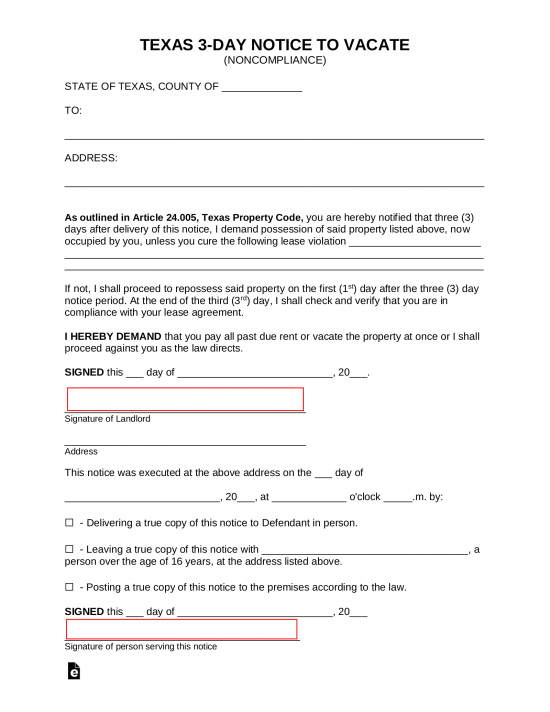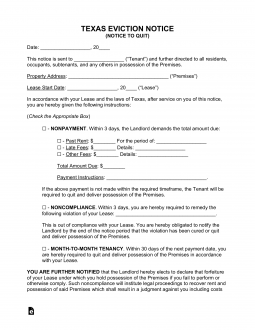Updated April 05, 2024
A Texas eviction notice is used by a landlord to notify a tenant of a lease violation. The landlord must notify the tenant and describe the offense committed and the number of days to fix it. Once the issue is fixed, the lease will continue as before. If the tenant does not respond, the landlord can file an eviction case (Forcible Entry and Detainer) at the Justice of the Peace Court.
By Type (3)
 3-Day Notice to Quit (Non-Payment of Rent) – This form is to notify a tenant that if they do not pay the past due rent, they will be subject to eviction. 3-Day Notice to Quit (Non-Payment of Rent) – This form is to notify a tenant that if they do not pay the past due rent, they will be subject to eviction.
Download: PDF, MS Word, OpenDocument |
 3-Day Notice to Quit (Non-Compliance) – This form notifies a tenant that they have breached the lease and that the landlord will seek eviction if the breach has not been rectified within three days. 3-Day Notice to Quit (Non-Compliance) – This form notifies a tenant that they have breached the lease and that the landlord will seek eviction if the breach has not been rectified within three days.
Download: PDF, MS Word, OpenDocument |
 30-Day Notice to Quit (Month-to-Month Tenancy) – This form notifies a tenant or landlord that the other party does not intend to renew the tenancy at the end of 30 days. 30-Day Notice to Quit (Month-to-Month Tenancy) – This form notifies a tenant or landlord that the other party does not intend to renew the tenancy at the end of 30 days.
Download: PDF, MS Word, OpenDocument |
Table of Contents |
Prohibited Landlord Actions
Utility Shutoff – If a landlord interrupts a tenant’s utility services for any reason other than repairs, construction, or an emergency, the tenant may terminate the lease or recover damages, one month’s rent plus $1,000, attorney’s fees, and court costs.[5]
Changing the Locks – A landlord has the right to change the lock for late rent only if it is specified in the lease. State law requires landlords to notify the tenant of this intent at least five days before changing the lock. In addition, the landlord must specify in the notice that the tenant has the right to obtain the new key at any hour, regardless of whether they pay the delinquent rent.[6]
Court Forms
The paperwork needed to evict a tenant in Texas will vary from county to county. To obtain the requisite documents, the landlord must contact the Justice of the Peace Court in the precinct where the property is located. The documents provided below should be used as samples only.
Petition for Eviction from Residential Premises – Filed by landlords when requesting a court order for the eviction of a tenant. This form might also be referred to as a “Complaint for Eviction” or “Petition: Eviction Case.”
Military Status Affidavit – Used to inform the court of whether or not the tenant is currently serving in the military. Landlords must include this affidavit with their eviction petition.
Case Information Sheet – Identifies the parties in the eviction case and defines the type of lawsuit being filed. This document must be filed when the initial eviction paperwork is submitted to the court.
Defendant’s Original Answer – Completed by the tenant after receiving notification of the eviction action filed against them. The tenant will use this form to state whether or not they agree with or deny the allegations made by the landlord.
Request for Writ of Possession (Sample) – If a tenant continues to occupy a rental after being evicted, the landlord may use this document to request a court order which authorizes law enforcement to remove the tenant from the premises.
How to Evict a Tenant (4 steps)
- Give the Tenant Notice
- File with the Local Court
- Tenant Files the Answer
- Attend the Scheduled Hearing
2. File with the Local Court

If the tenant fails to respond either by curing the breach or moving out within the requisite time period, the landlord may then proceed to the local Justice of the Peace Court to file a Complaint for Eviction (Sample). In addition to the complaint, the landlord must file a Case Information Sheet (Sample) and a Military Status Affidavit (Sample). These will have to be notarized before filing.
Filing fees vary by county.
3. Tenant Files the Answer

After the filing of the complaint, the tenant will have the option to reply to the court through the Original Answer (Sample). This form will display the tenant’s side of the story, and afterward, the court will give a hearing date. The court will then serve both parties with the date and time of the hearing.
4. Attend the Scheduled Hearing

If the landlord prevails in court, the tenant has five days to appeal. If the tenant does not appeal and remains on the premises, the landlord can file a Request for Writ of Possession (Sample) with the court, which, if granted, authorizes the sheriff to remove the tenant.
Sources
- Tex. Prop. Code § 92.019(3)
- Tex. Prop. Code § 24.005(a)
- Tex. Prop. Code § 91.001(b)(2)
- Tex. Prop. Code § 24.001 – 24.011
- Tex. Prop. Code §§ 92.008(a), 92.008(f)
- Tex. Prop. Code § 92.0081
- Harris County Civil Process Fees
- Dallas County: Justice of the Peace Filing Fees
- Tarrant County: JP Filing Fee Schedule



